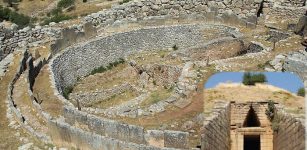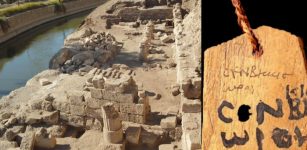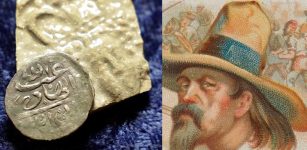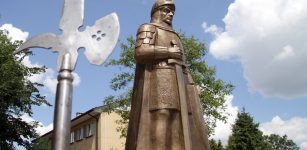Minutes Did Not Exist During The Middle Ages
Conny Waters - AncientPages.com - Medieval people used many instruments to keep track of time. During the Middle Ages, a combination of water clocks, sundials, and candle clocks could tell time, but none could determine the time to the minute.
Prague astronomical clock. Steve Collis from Melbourne, Australia - CC BY 2.0
Minutes were simply not used to measure time during the Middle Ages. Both the medieval and modern "day" (sunrise to sunrise) contain 24 hours, but medieval hours varied in length with the month and the time of day.
While the best water clocks told time to the quarter hour, people could tell time to the minute until the wide use and improvement of mechanical clocks.
On the equinoxes (March 21 and September 21), a medieval daylight hour equaled a nighttime hour, each containing a modern 60 minutes. But on Christmas in medieval London, a daylight hour contained only 40 minutes, while each nighttime hour contained 80 minutes. Of course, on St. John's Day (June 24), a medieval daylight hour in London had 80 minutes, and a nighttime hour contained only 40 minutes.
Žatec clock. Tower clock of Hop and Beer Temple. image credit: Martin Stross - CC BY-SA 3.0
We measure time in units of sixty because we still use the system worked out by the Sumerian civilization, which flourished in Mesopotamia about 2,000 B.C.E.
The Sumerians invented the Sexagesimal System based on the number 60. Sixty seconds in a minute, sixty minutes in an hour - and the Sumerians also had a calendar with 360 (60x6) days in a year. To make it work for all time units, the Sumerians also fixed twelve hours (double six) in a day, midnight, and roughly 12 months in a year (especially in a 360-day year).
The Babylonians, who lived after the Sumerians in Mesopotamia, also based their mathematics on the number 60. It was because the number 60 is a superior, highly composite number, having factors of 1, 2, 3, 4, 5, 6, 10, 12, 15, 20, 30, and 60.
The ancient Egyptians were no different and used time calculation on the number 60. They divided their year into three 120-day seasons of four months of 30 days. They defined the hour as either 1/12 of daytime or 1/12 of nighttime.
However, it took a long time before we started using minutes as a time measurement.
Jost Burgieven is credited with inventing the minute hand in 1577. The minute hand was not widely added to clocks until the 1680s. The mechanical clock was developed to a reasonable accuracy level in the 14th and 15th centuries.
In the 17th century, pendulum clocks were developed, enabling the measurement of seconds and minutes. The Royal Society in the U.K. first proposed the second as a unit of time. The duration of a beat or half period (one swing, not back and forth) of a pendulum one meter in length on the earth's surface is approximately one second.
Written by Conny Waters - AncientPages.com Staff Writer
Copyright © AncientPages.com All rights reserved. This material may not be published, broadcast, rewritten or redistributed in whole or part without the express written permission of AncientPages.com
Expand for referencesMore From Ancient Pages
-
 Sailing With The Phoenicians: Great Traders, Sailors And Navigators
News | Sep 6, 2015
Sailing With The Phoenicians: Great Traders, Sailors And Navigators
News | Sep 6, 2015 -
 Mysterious Hammer Of Thor In Canada Was Built Before The Arrival Of The Inuit – Did Vikings Raise The Monument?
Featured Stories | Jan 22, 2018
Mysterious Hammer Of Thor In Canada Was Built Before The Arrival Of The Inuit – Did Vikings Raise The Monument?
Featured Stories | Jan 22, 2018 -
 Secrets Of Ancient Skeletons Found In York – Who Were They And Where Did They Come From?
Archaeology | Jan 20, 2016
Secrets Of Ancient Skeletons Found In York – Who Were They And Where Did They Come From?
Archaeology | Jan 20, 2016 -
 Livestock And Dairying Led To Dramatic Social Changes In Ancient Mongolia – New Study
Archaeology | May 11, 2022
Livestock And Dairying Led To Dramatic Social Changes In Ancient Mongolia – New Study
Archaeology | May 11, 2022 -
 Ancient Basilica Cistern: Intriguing Hidden Subterranean World With Medusa Heads
Featured Stories | Dec 11, 2018
Ancient Basilica Cistern: Intriguing Hidden Subterranean World With Medusa Heads
Featured Stories | Dec 11, 2018 -
 The Americas Were Not Populated Via The Ice-Free Corridor More Than 15,600 Years Ago – New Study Of Boulders Reveals
Archaeology | Mar 23, 2022
The Americas Were Not Populated Via The Ice-Free Corridor More Than 15,600 Years Ago – New Study Of Boulders Reveals
Archaeology | Mar 23, 2022 -
 Mycenae Kingdom: Home To King Agamemnon And Tholos Tomb ‘Treasure of Atreus’
Civilizations | Jun 11, 2022
Mycenae Kingdom: Home To King Agamemnon And Tholos Tomb ‘Treasure of Atreus’
Civilizations | Jun 11, 2022 -
 Baalbek: Were The Megaliths Put In Place Under Herod?
Archaeology | May 27, 2019
Baalbek: Were The Megaliths Put In Place Under Herod?
Archaeology | May 27, 2019 -
 Unique Finds Discovered In Oman – Rub’al-Chali Desert Reveals Its Secrets
Archaeology | Apr 20, 2023
Unique Finds Discovered In Oman – Rub’al-Chali Desert Reveals Its Secrets
Archaeology | Apr 20, 2023 -
 Ancient Egyptian Temple, 30 Mummy Cards, 85 Tombs And Surveillance Points From The Era Of Ptolemy IIIs Discovered In Sohag
Archaeology | May 5, 2022
Ancient Egyptian Temple, 30 Mummy Cards, 85 Tombs And Surveillance Points From The Era Of Ptolemy IIIs Discovered In Sohag
Archaeology | May 5, 2022 -
 Secrets Of Iron Age Power Center Uppåkra Revealed By Archaeologists
Archaeology | Oct 22, 2022
Secrets Of Iron Age Power Center Uppåkra Revealed By Archaeologists
Archaeology | Oct 22, 2022 -
 Can This Ancient Coin Solve The Mysterious Disappearance Of Pirate Henry Every?
Archaeology | Apr 1, 2021
Can This Ancient Coin Solve The Mysterious Disappearance Of Pirate Henry Every?
Archaeology | Apr 1, 2021 -
 The Unicorn In The Bible Was An Oryx – Ancient Translation Mistake
Ancient History Facts | Apr 24, 2018
The Unicorn In The Bible Was An Oryx – Ancient Translation Mistake
Ancient History Facts | Apr 24, 2018 -
 Unexplained Encounters With Unknown Beings In California – Old And Modern Reports
Featured Stories | Mar 11, 2024
Unexplained Encounters With Unknown Beings In California – Old And Modern Reports
Featured Stories | Mar 11, 2024 -
 Keeladi, India: Ancient Residents Along Vaigai River Had Adopted Highly Progressive Technologies
Archaeology | Aug 28, 2020
Keeladi, India: Ancient Residents Along Vaigai River Had Adopted Highly Progressive Technologies
Archaeology | Aug 28, 2020 -
 Zawisza Czarny: Most Famous Polish Knight And The Quest For His Family Home
Featured Stories | Apr 26, 2016
Zawisza Czarny: Most Famous Polish Knight And The Quest For His Family Home
Featured Stories | Apr 26, 2016 -
 Tomb Of A 1,000-Year-Old Sican Surgeon Wearing A Golden Mask Discovered In Peru
Archaeology | Mar 30, 2022
Tomb Of A 1,000-Year-Old Sican Surgeon Wearing A Golden Mask Discovered In Peru
Archaeology | Mar 30, 2022 -
 Unknown Energy Source Created The Image On The Shroud Of Turin Scientists Suggest
Archaeology | May 12, 2012
Unknown Energy Source Created The Image On The Shroud Of Turin Scientists Suggest
Archaeology | May 12, 2012 -
 Strange Engraving Made By Knights Templar In French Village – Riddle Of The Rod – Part 1
Featured Stories | Oct 7, 2019
Strange Engraving Made By Knights Templar In French Village – Riddle Of The Rod – Part 1
Featured Stories | Oct 7, 2019 -
 Mystery Why Vikings Left Greenland Has Been Solved By Scientists
Archaeology | Mar 23, 2022
Mystery Why Vikings Left Greenland Has Been Solved By Scientists
Archaeology | Mar 23, 2022


